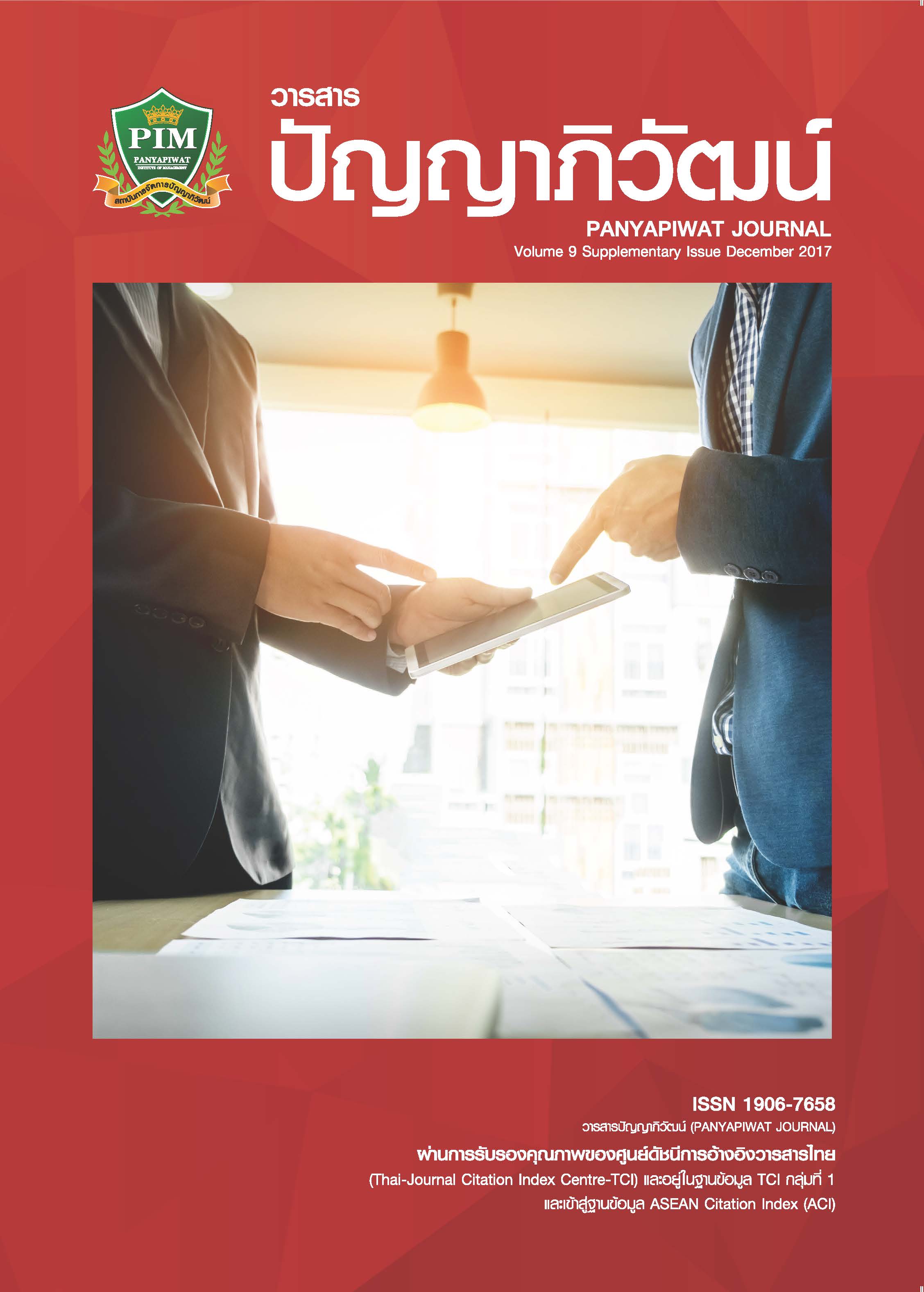A COMPARATIVE STUDY ON GOVERNMENT POLICY REGARDING SMALL-SIZED SCHOOLS IN CHINA AND THAILAND: A CASE STUDY OF SHANGYOU COUNTY IN GANZHOU CITY, CHINA AND NAM PHONG DISTRICT IN KHON KAEN, THAILAND
Main Article Content
บทคัดย่อ
This research investigated government policies regarding small-sized schools in China and Thailand. The objectives of the study were: 1) to study the current situation of small-sized schools in two places, 2) to analyze the problems of small-sized schools faced by two case schools, and 3) to compare the policies adopted by two local governments.
The data were obtained from two case schools, Taozhu Primary School in Shangyou County, China and Phrathat Kham Kaen Pittayalai School in Nam Phong District, Thailand. The key informants included school administrations, teachers, students and parents from these two schools, totaling 22 people. Data were analyzed with content analysis, application of the case study method, and summarized report in descriptive manner. It was found that the small-sized schools in both places face problems and challenges. The same problems of small-sized schools in both places were: 1) the heavy workload of teachers, 2) the lack of professional teachers, multimedia sources and scientific laboratory equipment. And 3) the students were mostly left-behind children with a lack of family education and weak learning ability. A difference between the two case study schools was that there were relatively lower level of teacher education in the Taozhu Primary School, and teachers’ lack of in-service training opportunities.
The policies implemented by the Shangyou County government include the Specially Contracted Teachers Plan, the Nutri-meal Plan, the Weak School Reform Plan and the Curriculum Reform Plan. Nam Phong District is implementing projects on School-based Management for Local Development and an Opportunity Expansion School model.
งานวิจัยนี้เป็นการศึกษานโยบายของรัฐบาลที่เกี่ยวกับโรงเรียนขนาดเล็กในประเทศจีนและประเทศไทย วัตถุประสงค์ของการศึกษานี้มีดังนี้ 1) เพื่อศึกษาสภาพทั่วไปของโรงเรียนขนาดเล็กของทั้งสองโรงเรียน 2) เพื่อวิเคราะห์ปัญหาของโรงเรียนขนาดเล็กของทั้งสองโรงเรียน 3) เพื่อเปรียบเทียบนโยบายด้านการศึกษาขององค์กรปกครองส่วนท้องถิ่นของทั้งสองประเทศ
ข้อมูลที่ใช้ในการศึกษานี้ได้มาจากกรณีศึกษาของทั้งสองโรงเรียน คือ โรงเรียนประถมเถาจู (Taozhu Primary School) ในเขตชางโหยว เมืองก้านโจว ประเทศจีน และโรงเรียนพระธาตุขามแก่นพิทยาลัย ในอำเภอน้ำพอง จังหวัดขอนแก่น ประเทศไทย ผู้ที่ให้ข้อมูลหลัก ได้แก่ ฝ่ายบริหาร ครู นักเรียน และผู้ปกครองของทั้งสองโรงเรียน จำนวนทั้งหมด 22 คน ข้อมูลที่ได้นำมาวิเคราะห์เชิงเนื้อหา (Content Analysis) ใช้กระบวนการวิเคราะห์กรณีศึกษา และสรุปรายงานเชิงพรรณนาความ
จากการศึกษาพบว่า โรงเรียนขนาดเล็กทั้งสองแห่งมีปัญหาและความท้าทายต่างๆ โดยปัญหาที่ทั้งสองโรงเรียนพบเหมือนกัน คือ 1) ครูมีภาระงานที่มากเกินไป 2) ขาดแคลนครูที่มีความเป็นมืออาชีพ ขาดสื่อการสอนที่มีคุณภาพ และขาดอุปกรณ์ที่ใช้ในห้องปฏิบัติการทางวิทยาศาสตร์ และ 3) นักเรียนส่วนใหญ่ไม่ได้อาศัยอยู่กับพ่อแม่ทำให้ขาดความอบอุ่น มีผลให้มีความสามารถในการเรียนรู้ที่ต่ำ ข้อแตกต่างระหว่างสองโรงเรียน คือ การศึกษาของครูในโรงเรียนเถาจูต่ำกว่าครูในโรงเรียนพระธาตุขามแก่นพิทยาลัย และครูในโรงเรียนเถาจูได้รับโอกาสในการอบรมเกี่ยวกับการเรียนการสอนไม่เพียงพอ
การขับเคลื่อนนโยบายองค์กรปกครองส่วนท้องถิ่นในเขตชางโหยวนั้นมีนโยบายที่เกี่ยวกับแผนการทำสัญญาพิเศษของครู (Specially Contracted Teacher Plan) แผนการโภชนาการ (The Nutria-Meal Plan) แผนการปรับปรุงโรงเรียนที่ด้อยคุณภาพ (Weak School Reform Plan) และแผนการปรับปรุงหลักสูตรการศึกษา (Curriculum Reform Plan) ส่วนองค์กรปกครองส่วนท้องถิ่นของจังหวัดขอนแก่น มีการนำโครงการบริหารโดยใช้โรงเรียนเป็นฐาน (School-Based Management) ในการพัฒนาท้องถิ่น และโครงการโรงเรียนขยายโอกาสทางการศึกษา (Opportunity Expansion School Model) มาใช้
Article Details
“ข้าพเจ้าและผู้เขียนร่วม (ถ้ามี) ขอรับรองว่า บทความที่เสนอมานี้ยังไม่เคยได้รับการตีพิมพ์และไม่ได้อยู่ระหว่างกระบวนการพิจารณาลงตีพิมพ์ในวารสารหรือแหล่งเผยแพร่อื่นใด ข้าพเจ้าและผู้เขียนร่วมยอมรับหลักเกณฑ์การพิจารณาต้นฉบับ ทั้งยินยอมให้กองบรรณาธิการมีสิทธิ์พิจารณาและตรวจแก้ต้นฉบับได้ตามที่เห็นสมควร พร้อมนี้ขอมอบลิขสิทธิ์บทความที่ได้รับการตีพิมพ์ให้แก่สถาบันการจัดการปัญญาภิวัฒน์หากมีการฟ้องร้องเรื่องการละเมิดลิขสิทธิ์เกี่ยวกับภาพ กราฟ ข้อความส่วนใดส่วนหนึ่งและ/หรือข้อคิดเห็นที่ปรากฏในบทความข้าพเจ้าและผู้เขียนร่วมยินยอมรับผิดชอบแต่เพียงฝ่ายเดียว”
เอกสารอ้างอิง
Buaraphan, K. (2013). Educational Quality of Small Schools in Thailand. European Journal of Social Sciences, 41(1), 130-147. [in Thai]
Chaiyamee, P. (2016). Effective Strategies for Administering Sufficiency Schools. Panyapiwat Journal, 8(2), 168-182. [in Thai]
China Rural Education Development Report 2016. (2016). China Rural Education Development Institute of Northeast Normal university. Retrieved February 17, 2017, from https://news.jyb.cn/china/gnxw/ 201612/t20161226_691183.html [in Chinese]
Choompala, C., Pongpinyo, P. & Larsak, P. (2014). Research Report on A Case Study: Successful Model of Education Management in Small Schools in Northeast of Thailand. Bangkok: The Thailand Research Fund. [in Thai]
Coleman, J. S. (1966). Equality of Education Opportunity. Washington, DC: US Department of Health, Education, and Welfare, Office of Education.
Gordon, W., Lokisso, A. & Allen, J. (1997). Enhancing the effectiveness of single teacher schools and multi-grade classes. Norway: Royal Ministry of Education Research and Church Affairs.
Huang, D. (2003). A Comparative Study of School Management System in China and West.1994-2011 China Academic Journal Electronic Publishing House. [In Chinese]
Jones, C. O. (1984). An Introduction to the Study of Public Policy. Monterey, CA: Brooks/Cole Publishing.
Lei, W. P. & Zhang, X. Y. (2011). Discussion on Classification Development Policy of Rural Small-scale Schools. The Journal of Educational Research and Experiment, 21(6), 7-11.
Lei, W. P. & Zhang, X. Y. (2014). Investigation on Resource Allocation and Operating mechanism of rural small-scale schools. People’s Education, 64(6), 29-32. [in Chinese]
Merriam-Webster Dictionary. (n.d.). Definition of decentralization. Retrieved February 17, 2017, from https://www.merriam-webster.com/dictionary/decentralization
Murphy, J. (1994).Principles of School-based Management. Carolina, USA: The University of North Carolina Press.
Nenyod, B. (2002). School-Based Management: Thai Ways and Methods. Bangkok: Office of the National Education Commission. [in Thai]
Office of the Basic Education Commission. (2015). Annual Report 2015. Bangkok: Office of the Basic Education Commission, Ministry of Education of Thailand. [in Thai]
Pinyowong, E. (2010). Small-sized school management. Retrieved February 17, 2017, from https://www.gotoknow.org/posts/343990 [in Thai]
Sasithorn, L. (2015). Managing small schools by combining small schools into groups, under the Krabi primary education service area office. Master of Education Degree in Administration, Hatyai University.
Sigsworth, A. & Solstad, K. J. (2001). Making small-sized schools work: A Handbook for Teachers in Small Rural Schools. UNESCO, International Institute for Capacity Building in Africa.
The Free Dictionary. (n.d.). Definition of decentralization. Retrieved February 20, 2017, from https://www.thefreedictionary.com/decentralization
The Rural School and Community Trust. (2003). School Size: Research Based Conclusions. The Rural School and Community Trust. Retrieved February 13, 2017, from https://www.ruraledu.org/articles.php?id=2038
Upper Secondary Education Bureau of Thailand. (2011). Guidelines of budgeting and management of budgeting of Secondary Education Services Area Office. Retrieved December 20, 2016, from https://www.sesao1.go.th/media/files/budget.pdf
Zhang, X. (2012). A Policy Study on Rural Small Schools Development. Central China Normal University. [in Chinese]


